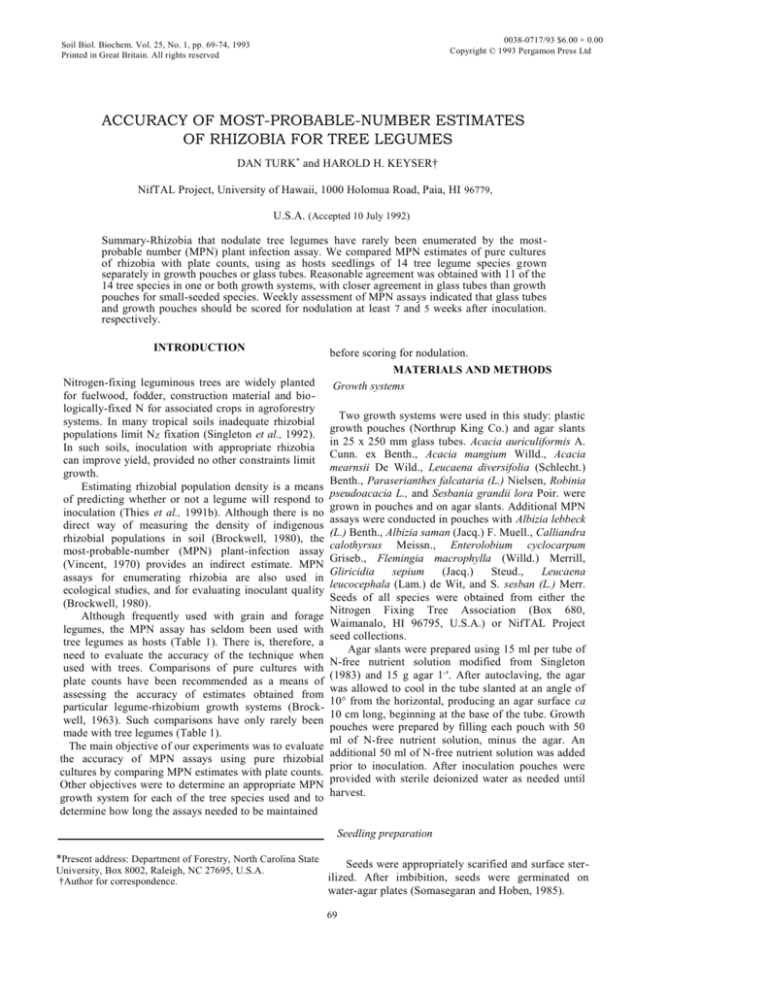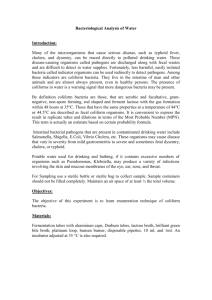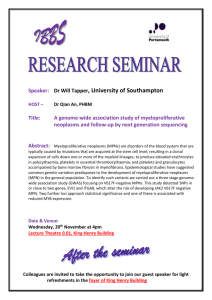
0038-0717/93 $6.00 + 0.00
Copyright © 1993 Pergamon Press Ltd
Soil Biol. Biochem. Vol. 25, No. 1, pp. 69-74, 1993
Printed in Great Britain. All rights reserved
ACCURACY OF MOST-PROBABLE-NUMBER ESTIMATES
OF RHIZOBIA FOR TREE LEGUMES
DAN TURK* and HAROLD H. KEYSER†
NifTAL Project, University of Hawaii, 1000 Holomua Road, Paia, HI 96779,
U.S.A. (Accepted 10 July 1992)
Summary-Rhizobia that nodulate tree legumes have rarely been enumerated by the mostprobable number (MPN) plant infection assay. We compared MPN estimates of pure cultures
of rhizobia with plate counts, using as hosts seedlings of 14 tree legume species grown
separately in growth pouches or glass tubes. Reasonable agreement was obtained with 11 of the
14 tree species in one or both growth systems, with closer agreement in glass tubes than growth
pouches for small-seeded species. Weekly assessment of MPN assays indicated that glass tubes
and growth pouches should be scored for nodulation at least 7 and 5 weeks after inoculation.
respectively.
INTRODUCTION
Nitrogen-fixing leguminous trees are widely planted
for fuelwood, fodder, construction material and biologically-fixed N for associated crops in agroforestry
systems. In many tropical soils inadequate rhizobial
populations limit N Z fixation (Singleton et al., 1992).
In such soils, inoculation with appropriate rhizobia
can improve yield, provided no other constraints limit
growth.
Estimating rhizobial population density is a means
of predicting whether or not a legume will respond to
inoculation (Thies et al., 1991b). Although there is no
direct way of measuring the density of indigenous
rhizobial populations in soil (Brockwell, 1980), the
most-probable-number (MPN) plant-infection assay
(Vincent, 1970) provides an indirect estimate. MPN
assays for enumerating rhizobia are also used in
ecological studies, and for evaluating inoculant quality
(Brockwell, 1980).
Although frequently used with grain and forage
legumes, the MPN assay has seldom been used with
tree legumes as hosts (Table 1). There is, therefore, a
need to evaluate the accuracy of the technique when
used with trees. Comparisons of pure cultures with
plate counts have been recommended as a means of
assessing the accuracy of estimates obtained from
particular legume-rhizobium growth systems (Brockwell, 1963). Such comparisons have only rarely been
made with tree legumes (Table 1).
The main objective of our experiments was to evaluate
the accuracy of MPN assays using pure rhizobial
cultures by comparing MPN estimates with plate counts.
Other objectives were to determine an appropriate MPN
growth system for each of the tree species used and to
determine how long the assays needed to be maintained
before scoring for nodulation.
MATERIALS AND METHODS
Growth systems
Two growth systems were used in this study: plastic
growth pouches (Northrup King Co.) and agar slants
in 25 x 250 mm glass tubes. Acacia auriculiformis A.
Cunn. ex Benth., Acacia mangium Willd., Acacia
mearnsii De Wild., Leucaena diversifolia (Schlecht.)
Benth., Paraserianthes falcataria (L.) Nielsen, Robinia
pseudoacacia L., and Sesbania grandii lora Poir. were
grown in pouches and on agar slants. Additional MPN
assays were conducted in pouches with Albizia lebbeck
(L.) Benth., Albizia saman (Jacq.) F. Muell., Calliandra
calothyrsus Meissn., Enterolobium cyclocarpum
Griseb., Flemingia macrophylla (Willd.) Merrill,
Gliricidia
sepium
(Jacq.)
Steud.,
Leucaena
leucocephala (Lam.) de Wit, and S. sesban (L.) Merr.
Seeds of all species were obtained from either the
Nitrogen Fixing Tree Association (Box 680,
Waimanalo, HI 96795, U.S.A.) or NifTAL Project
seed collections.
Agar slants were prepared using 15 ml per tube of
N-free nutrient solution modified from Singleton
(1983) and 15 g agar 1-'. After autoclaving, the agar
was allowed to cool in the tube slanted at an angle of
10° from the horizontal, producing an agar surface ca
10 cm long, beginning at the base of the tube. Growth
pouches were prepared by filling each pouch with 50
ml of N-free nutrient solution, minus the agar. An
additional 50 ml of N-free nutrient solution was added
prior to inoculation. After inoculation pouches were
provided with sterile deionized water as needed until
harvest.
Seedling preparation
*Present address: Department of Forestry, North Carolina State
University, Box 8002, Raleigh, NC 27695, U.S.A.
†Author for correspondence.
Seeds were appropriately scarified and surface sterilized. After imbibition, seeds were germinated on
water-agar plates (Somasegaran and Hoben, 1985).
69
2
Two to five days later, when radicles had reached 0.5-1.5
cm in length, the seed coats of uniform seedlings were
removed to prevent seed coat hardening and to facilitate
examination of tubes for nodulation. In tubes, seedlings
were placed on the surface of the agar, with the root collar
ca 6-7 cm from the bottom of the slant. One and two
seedlings were planted in tubes and pouches respectively.
After planting, racks of pouches and tubes were placed in
a growth room receiving > 300 μE m-2 s-1 of
photosynthetically-active radiation at plant height for 16 h
day--1 from 1000 W high-pressure sodium lamps.
Prior to inoculation, growth units with poorly growing
plants were eliminated. These included tubes with
seedlings whose tap roots penetrated the surface of the
agar, in accordance with the observation of Woomer et al.
(1988b) that agar penetration by roots of L. leucocephala
resulted in poor nodulation. Enough uniform plant growth
units were retained for at least six dilution levels of four
replicate growth units each.
Rhizobial cultures, inoculation, and plate counts
Rhizobial strains (Table 2) were grown for 6-10 days in
either yeast-extract mannitol broth (Vincent, 1970) or
arabinose-gluconate medium (Sadowsky et al., 1987).
Cultures were serially diluted using either 4- or 10-fold
dilution ratios as outlined in Somasegaran and Hoben (1985).
The diluent contained the salts found in yeast-extract mannitol
broth (Vincent, 1970) with 0.01 % Tween 80 (Fisher Scientific Co.) added as a surfactant.
Seedlings were inoculated 7-12 days after planting, when
root radicles had reached the bottom of the tubes or had begun
to differentiate into secondary roots in pouches. Diluted
rhizobial culture (1 ml) was applied directly to roots in
pouches and to the lower portion of roots in tubes. An average
of seven uninoculated growth units were included per MPN
assay as checks for contamination within the system.
Uninoculated controls received 1 ml of rhizobia-free diluent.
Plate counts were conducted at the time of inoculation
using the Miles and Misra drop plate method (Somasegaran
and Hoben, 1985). At least four replicate 30 pl aliquots were
used from each of three dilution levels from the inoculation
dilution series. Prior to data collection, plates were kept at
27°C for 7-10 days for strains of Bradyrhizobium Jordan, and
for 3-5 days for strains of Rhizobium Frank.
3
MPN estimates for tree legumes
> 25 mg seed-' (S. grandiora, A. lebbeck, Albizia
MPN determinations
With two exceptions scored at 4 weeks, growth units
of MPN assays were scored for nodulation 5-7 weeks
after inoculation. The MPN was determined using a
computer program (Woomer et al., 1990), beginning
with the lowest dilution step in which all growth units
nodulated.
MPN assays in pouches and tubes containing A.
auriculiformis, Acacia mangium, A. mearnsii and
R. pseudoacacia, were scored weekly for nodulation
from the second to the seventh week after inoculation.
Weekly scores were also recorded for S. grandiflora
and L. diversifolia, grown in pouches and tubes
respectively.
RESULTS
Plate counts were within the corresponding 95%
confidence interval of MPN estimates (Cochran, 1950)
for 18 of 53 plate count-MPN comparisons (Table 3).
In all but three plate count-MPN comparisons the MPN
was lower than the plate count.
Rhizobial density of the original solutions ranged from
3.67 x 10' to 7.55 x 109 rhizobia ml-' as measured by the
plate count method. In every MPN assay, nodules were
found in only 5 of 384 uninoculated control growth units,
with never more than one nodulated control unit per assay.
Plate count: MPN estimate (PC: MPN) ratios < 35
were obtained in either tubes or pouches for 11 of the 14
tree species (Table 3). In tubes, all species with seed
weights < 25 mg seed-' (A. auriculiformis, Acacia
mangium, A. mearnsii, L. diversifolia, P. falcataria
and R. pseudoacacia) had average PC: MPN ratios <
26. In pouches, of six species with seed weight
saman, C. calothyrsus, G. sepium and L. leucocephala), all but two (A. lebbeck and Albizia saman)
had PC: MPN ratios < 35. Of the seven species grown in
tubes and pouches, five (A. auriculiformis, Acacia
mangium, A. mearnsii, P. falcataria and S. grandi
flora) had PC: MPN ratios > 200 in one of the two
growth systems.
Five of 10 MPN estimates from nodulation scores
taken weekly from 2 to 7 weeks after inoculation
increased after the fourth week (Fig. 1). No nodules
were formed in any of the 48 uninoculated control
growth units used in these assays. For species grown in
tubes and pouches, the average number of weeks to
arrive at the final MPN estimate was 6.0 in tubes
compared with 4.8 in pouches. In tubes, the MPN
estimates of A. auriculiformis and A. mearnsii increased during the interval from 6 to 7 weeks after
inoculation. In pouches, the MPN estimate of only one
species, Acacia mangium, increased in the interval
from 5 to 6 weeks and no species after 6 weeks.
DISCUSSION
Comparing MPN estimates with plate counts of pure
rhizobial cultures indicates the degree of compliance of
the MPN assay with its major underlying assumption, that
the presence of a single rhizobium will result in nodule
formation (Scott and Porter, 1986). The comparison
provides an indication of a growth system's potential for
accurate results using a particular species and set of
growth conditions. This is the basis for recommending
that pure culture comparisons of MPN estimates with
plate counts accompany MPN assays conducted in soil
for each growth system-species combination used
4
(Thompson and Vincent 1967; Scott and Porter, 1986;
Singleton et al., 1991).
MPN estimates obtained with a variety of grain and
forage legumes indicate that the MPN assay tends to
underestimate plate counts, suggesting that one
rhizobium is generally not sufficient to cause nodule
formation. PC: MPN ratios < 6 have been obtained
with many herbaceous legumes including Trifolium
spp (Brockwell, 1963; Tuzimura and Watanabe,
1961), Medicago sativa (Weaver and Frederick, 1972;
Scott and Porter, 1986), Cicer arietinum (Toomsan et
al., 1984) and Glycine spp (Weaver and Frederick,
1972; Brockwell et al., 1975). The discrepancy of <
1.5 log units between MPN estimates and plate counts
obtained with A. mearnsii, L. diversifolia and P.
falcataria in tubes and with L. diversifolia, C.
calothyrsus and S. sesban in pouches, indicates that
reasonable agreement between MPN estimates and
plate counts can also be obtained with a variety of tree
legumes.
Our results with trees agreed with the recommendation
of Vincent (1970) that agar slants are suitable for
legumes with seed weight less than that of "vetch", ca
25 mg seed-1. Growth pouches were suitable for most
larger-seeded tree species, but not for A. lebbeck and
Albizia saman. Other growth systems, such as Leonard
jars, should be evaluated for these species.
Growth pouches were not suitable growth systems for
seven of the 14 tree species and tubes not suitable for S.
grandiflora. These combinations had PC: MPN ratios >
100, indicating that over 100 rhizobia were required for
nodule formation in these particular systems. Other
authors have reported large discrepancies between plate
counts and MPN estimates, notably Boonkerd and
Weaver (1982), who reported PC: MPN ratios in
pouches > 250 for Vigna unguiculata and Macroptilium
atropurpureum. Boonkerd and Weaver (1982) suggested
that the large ratios obtained were due to the inherent
inability of these legumes to nodulate with a single
rhizobial cell.
MPN estimates for tree legumes
However, large PC: MPN ratios from species grown in
only one of the two growth systems used in these
experiments imply that problems with nodulation are
growth-system related. The range of PC: MPN ratios
observed emphasizes the need to evaluate growth systemspecies combinations prior to performing MPN assays for
experimental purposes.
Woomer et al. (1988b) noted the importance of
placing the diluted inoculant directly on the roots of the
plants to get good nodulation. They noticed that the
roots of M. atropurpureum tended to accumulate at the
bottom of the glass tube without growing extensively on
the surface of the slanted agar where the inoculant was
applied and found that estimating rhizobial populations
with this species was less precise than for species with
greater root proliferation. We observed that roots of the
Acacia spp, in particular, did not grow extensively on the
agar surface, with most nodulation occurring at the
bottom of the tubes. The quantity of agar we used and
the angle of the slant, were, therefore, designed to
channel both roots and rhizobia directly to the bottom of
the tube to ensure maximal contact between them. We
found that 15 ml of agar was sufficient to support
growth of tree seedlings for the duration of the assays.
Weekly assessment of MPN estimates (Fig.1)
indicated the importance of keeping tubes for at least 7
weeks and pouches for at least 5 weeks after inoculation.
Delayed nodule formation in tubes relative to pouches
appeared to be related to longer retention of
photosynthetic capability: seedlings in tubes remained
healthy longer than plants in pouches, despite being
smaller. These times for scoring nodulated growth units
are longer than recommended for other legumes. For grain
and forage legumes, 2-4 weeks have been recommended
as adequate by Vincent (1970), Brockwell (1980) and
Boonkerd and Weaver (1982). Reports of times to
assessment of MPN assays with tree legumes (Table 1)
indicate a range from 2 to 3 weeks to 11 weeks after
inoculation, with nodulation in four of seven reports
assessed at S 3 weeks. Our results suggest that scoring at <
5 weeks is likely to underestimate the true population
density, at least for species other than L. leucocephala
In conclusion, the results from our experiments
provide a basis for selecting appropriate growth systems
for MPN assays with a range of tree species. They show
that MPN assays can provide accurate estimates of
rhizobial populations for tree legumes but point to the
need for selecting growth systems that are tailored to the
characteristics of the particular tree species being used. It
is imperative that growth systems be tested for each tree
species using pure cultures of rhizobia prior to conducting
MPN assays with soils.
Acknowledgements-We thank Kathy MacGlashan, Patty
Nakao and Joe Rourke for technical assistance, and Paul
Singleton and Janice Thies for reviewing the manuscript.
5
This publication was made possible through support
provided under cooperative agreements by the United
States Agency for International Development, Office of
Agriculture, Bureau of Research and Development.
Conclusions in this paper and mention of product names
do not constitute an endorsement by USAID. Journal
series No. 3663 of the Hawaii Institute of Tropical
Agriculture and Human Resources.
REFERENCES
Boonkerd N. and Weaver R. W. (1982) Cowpea rhizobia:
comparison of plant infection and plate counts. Soil
Biology & Biochemistry 14, 305-307.
Brockwell J. (1963) Accuracy of a plant-infection
technique for counting populations of Rhizobium trifolii.
Applied Microbiology 2, 377-383.
Brockwell J. (1980) Experiments with crop and pasture
legumes-principles and practice. In Methods for Evaluating Biological Nitrogen Fixation (F. J. Bergersen, Ed.), pp.
417-488. Wiley, Chichester.
Brockwell J., Diatloff A., Grassia A. and Robinson A. C.
(1975) Use of wild soybean (Glycine ussuriensis Regel
and Maack) as a test plant in dilution-nodulation
frequency tests for counting Rhizobium japonicum. Soil
Biology & Biochemistry 7, 305-311.
Cochran W. G. (1950) Estimation of bacterial densities by
means of the "most-probable-number". Biometrics 6, 105116.
Davis P. E. (1982) Desmanthus virgatus as a test plant for
dilution-frequency infection tests using Leucaena leucocephala rhizobia. Soil Biology & Biochemistry 14, 313-314.
Sadowsky M. J., Tully R. E., Cregan P. B. and Keyser H.
H. (1987) Genetic diversity in Bradyrhizobium japonicum
serogroup 123 and its relation to genotype-specific nodulation of soybean. Applied and Environmental Microbiology 53, 2624-2630.
Sambrook J., Fritsch E. F. and Maniatis T. (1989) Molecular Cloning: A Laboratory Manual. 2nd Edn, Vol. 1.
Cold Spring Harbor Laboratory Press, Cold Spring
Harbor.
Sanginga N., Mulongoy K. and Ayanaba A. (1987) Evaluation of indigenous strains of Rhizobium for Leucaena
leucocephala (Lam.) De Wit in Nigeria conditions. In Les
Arbres Fixateurs d'Azote: 1'Amelioration Biologique de la
Fertilite des Sols, pp. 416-436. Colloques et Seminaires.
ORSTOM, Paris.
Sanginga N., Mulongoy K. and Ayanaba A. (1985) Effect
of inoculation and mineral nutrients on nodulation and
growth of Leucaena leucocephala. In Biological Nitrogen
Fixation in Africa: Proceedings of the African Association
for Biological Nitrogen Fixation (H. Ssali and S.O. Keya,
Eds), pp. 419-427. Matianum Press Consultants, Nairobi.
Scott J. M. and Porter F. E. (1986) An analysis of the
accuracy of a plant infection technique for counting
rhizobia. Soil Biology & Biochemistry 18, 355-362.
Singleton P. W. (1983) A split-root growth system of
evaluating components of the soybean-Rhizobium
japonicum symbiosis. Crop Science 23, 259-262.
Singleton P. W. and Tavares J. W. (1986) Inoculation
response of legumes in relation to the number and
effectiveness of indigenous rhizobium populations. Applied and Environmental Microbiology 51, 1013-1018.
Singleton P. W. Bohlool B. B. and Nakao P. L. (1992)
Legume response to rhizobial inoculation in the tropics:
myths and realities. In Myths and Science of Soils in the
Tropics (R. Lal and P. Sanchez, Eds), SSSA Special
Publication No. 29, pp. 135-155. American Society of
Agronomy, Madison.
Singleton P. W., Woomer P. L., Thies J. E., Nakao P. L.
and Bohlool B. B. (1991) Protocols for Field and
Greenhouse Experimentation in Legume BNF: Standardized
6
DAN TURK AND HAROLD H. KEYSER
Network Trials to Develop Models Describing the
Ecology and Performance of the Rhizobium-Legume
Symbiosis. University of Hawaii NiFFAL Project,
Paia.
Somasegaran P. and Hoben H. J. (1985) Methods in
Legume -Rhizobium Technology. University of
Hawaii NiFTAL Project, Paia.
Thies J. E., Singleton P. W. and Bohlool B. B.
(1991a) Influence of the size of indigenous
rhizobial populations on establishment and
symbiotic performance of introduced rhizobia on
field-grown legumes. Applied and Environmental
Microbiology 57, 19-28.
Thies J. E., Singleton P. W. and Bohlool B. B.
(1991b) Modeling symbiotic performance of
introduced rhizobia in the field by use of indices of
indigenous population size and nitrogen status of
the soil. Applied and Environmental Microbiology
57, 29-37.
Thompson J. A. and Vincent J. M. (1967) Methods of
detection and estimation of rhizobia in soil. Plant
and Soil 26, 72-84.
Toomsan B., Rupela O. P., Mittal S., Dart P. J. and
Clark K. W.(1984) Counting Cicer-Rhizobium using
a plant infection technique. Soil Biology &
Biochemistry 16, 503-507.
Tuzimura K. and Watanabe I. (1961) Estimation of
number of root-nodule bacteria by a nodulationdilution frequency method. Soil Science and Plant
Nutrition 7, 61-65.
Vincent J. M. (1970) A Manual for the Practical Study
of Root-Nodule Bacteria. Blackwell, Oxford.
Virginia R. A., Jenkins M. B. and Jarrell W. M.
(1986) Depth of root symbiont occurrence in soil.
Biology and Fertility of Soils 2, 127-130.
Weaver R. W. and Frederick L. R. (1972) A new
technique for most-probable-number counts of
Rhizobia. Plant and Soil 36, 219-222.
Woomer P., Bennett J. and Yost, R. (1990)
Overcoming the inflexibility of most-probablenumber procedures. Agronomy Journal 82, 349-353.
Woomer P., Singleton P. W. and Bohlool B. B.
(1988a) Ecological indicators of native rhizobia in
tropical
soils. Applied and Environmental
Microbiology 54, 1112-1116.
Woomer P., Singleton P. W. and Bohlool B. B.
(1988b) Reliability of the most-probable-number
technique for enumerating rhizobia in tropical soils.
Applied and Environmental Microbiology 54, 14941497.







